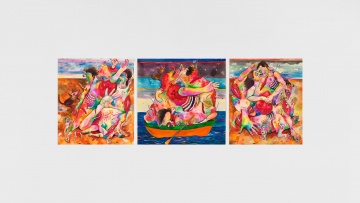George Adams Gallery
New York, NY 10013
212 564 8480
The George Adams Gallery traces its origins to the Allan Frumkin Gallery, founded in Chicago in 1952 with a New York location opening in 1959. George Adams’ association with the New York gallery began in 1980, with Mr. Adams and Mr. Frumkin forming a partnership, Frumkin/Adams Gallery, in 1988. Upon Mr. Frumkin’s retirement in 1995, the gallery assumed its present identity of George Adams Gallery.
From its inception, the gallery has introduced and promoted a diverse range of artists, most notably from the San Francisco Bay Area and Latin America, while mounting regular exhibitions of 20th Century European master drawings by such artists as Max Beckmann, Lovis Corinth, James Ensor, Alberto Giacometti, and Henri Matisse, among others. The rich history of the gallery includes the careers of artists such as Jeremy Anderson, Robert Barnes, William Beckman, Mel Chin, Joseph Cornell, Manny Farber, Paul Georges, Paul Granlund, Theodore Halkin, Robert Hudson, June Leaf, Arthur Liepzig, Maryan, James McGarrell, Willard Midgette, Philip Pearlstein, James Surls, James Valerio, and Sandy Winters. Beginning with Roberto Matta in the 1950s, the gallery played an important role in introducing contemporary Latin American art to American audiences. Subsequently the gallery gave first solo exhibitions in the United States for artists Luis Cruz Azaceta (1979), Jose Bedia (1991), Rosana Palzyan (1998), and Yoan Capote (2004), as well as exhibitions of works by Carlos Alfonzo, Luis Benedit, Juan Francisco Elso, and Arnaldo Roche-Rabell.
Today, the George Adams Gallery represents the estates of Robert Arneson (1930-1992), Jack Beal (1931-2013), Elmer Bischoff (1916-1991), Joan Brown (1938-1990), Roy De Forest (1930-2007), and Gregory Gillespie (1936-2000), while regularly exhibiting the work of contemporary artists such as Luis Cruz Azaceta, Enrique Chagoya, Diane Edison, Amer Kobaslija, Andrew Lenaghan, Peter Saul and William T. Wiley, and other emerging and under-recognized artists. Having a long association with art from the San Francisco Bay Area, the gallery’s program continues to champion art from the region through research and historical exhibitions of work by artists both from its roster and others.
Peter Saul


 Back to all Member Galleries
Back to all Member Galleries

